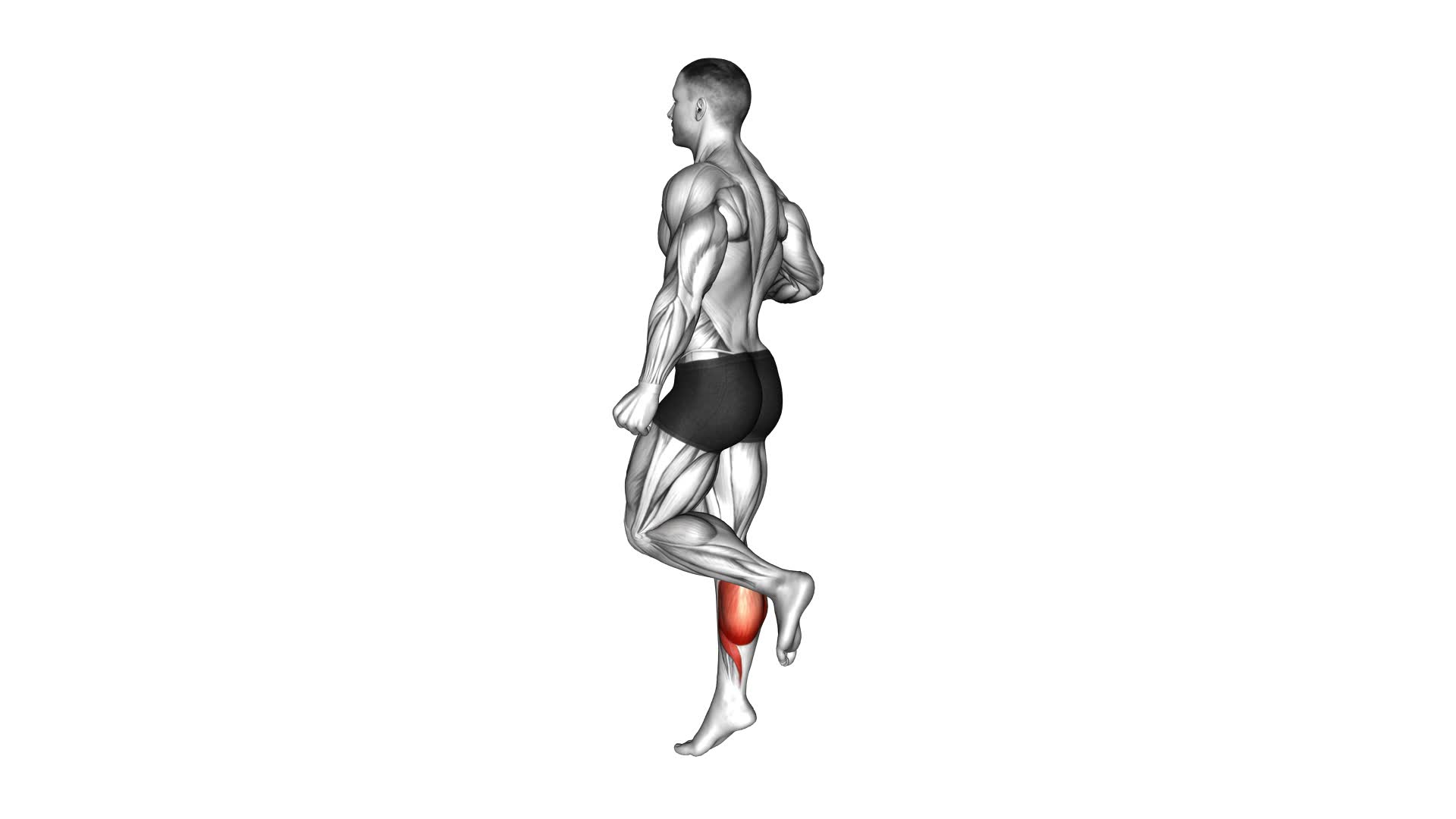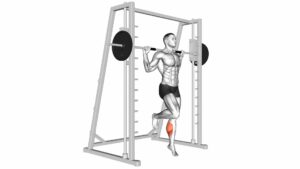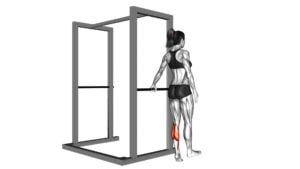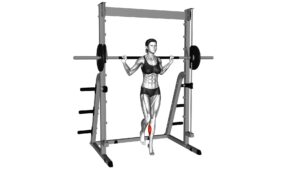One Leg Floor Calf Raise – Video Exercise Guide & Tips

Are you looking to strengthen your calves and improve your balance? Look no further than the one leg floor calf raise!
Watch This Exercise Video
In this video exercise guide, we'll show you the proper form and technique to get the most out of this exercise. Avoid common mistakes and discover variations to challenge yourself.
With these tips, you'll maximize your results and achieve stronger, more defined calf muscles.
Let's get started!
Key Takeaways
- Improved calf strength and stability
- Targeted activation of calf muscles
- Enhanced muscle tone and definition
- Reduced risk of ankle injuries
Benefits of One Leg Floor Calf Raise
The benefits of performing the one leg floor calf raise exercise include improved calf strength and stability. This exercise specifically targets the calf muscles, activating them for optimal growth and development. By standing on one leg and raising your heel off the ground, you're effectively engaging the gastrocnemius and soleus muscles in your calf.
Muscle activation is key in this exercise, as it helps to strengthen and tone the calf muscles. The one leg floor calf raise also improves stability and balance, as it requires you to maintain control and balance throughout the movement.
In addition to strengthening the calf muscles and improving stability, this exercise can also help prevent injuries. Strong calf muscles can provide better support and stability to the ankles, reducing the risk of sprains and strains. By regularly performing the one leg floor calf raise, you can enhance the strength and flexibility of your calves, making them less prone to injuries during physical activities.
Proper Form and Technique
To perform the one leg floor calf raise exercise with proper form and technique, you should start by:
- Standing with your feet hip-width apart and placing one foot slightly in front of the other.
- Keeping your back straight and engaging your core muscles to maintain stability throughout the exercise.
- Placing your hands on your hips or extending them out to the sides for balance.
Next, shift your weight onto the foot that will be working. Slowly rise up onto your toes, lifting your heel off the ground.
- Focus on using the muscles in your calf to lift your body upward.
- Hold this position for a brief moment at the top, then slowly lower your heel back down to the starting position.
Maintaining proper form is crucial for injury prevention and maximizing muscle activation.
- Make sure to avoid leaning forward or backward during the exercise, as this can strain your lower back.
- Keep your movements controlled and avoid using momentum to lift your body up.
By following these guidelines, you can ensure that you're performing the one leg floor calf raise exercise with proper form and technique, reducing the risk of injury and effectively activating your calf muscles.
Now, let's move on to the next section to learn about common mistakes to avoid when performing this exercise.
Common Mistakes to Avoid
To avoid common mistakes when performing the one leg floor calf raise exercise, make sure you maintain proper form and technique. One common mistake isn't keeping your back straight throughout the exercise. It's important to engage your core muscles and keep your spine aligned.
Another mistake is rushing through the movement. Take your time and focus on the contraction of your calf muscle at the top of the exercise. Another common mistake is using momentum to lift your body up instead of relying on your calf muscle strength. Remember to use a slow and controlled motion to ensure maximum effectiveness.
Additionally, avoid locking your knees at the top of the movement, as this can put excessive pressure on the joint. Instead, maintain a slight bend in your knees to protect your joints.
Lastly, make sure to choose the appropriate weight or resistance level for your fitness level. Using too heavy of a weight can compromise your form and increase the risk of injury.
Variations and Progressions
To vary and progress the one leg floor calf raise exercise, you can incorporate different modifications and advancements. Here are some alternative exercises and advanced techniques you can try:
- Elevated Calf Raises: Place the ball of your foot on an elevated surface, such as a step or block, and perform the calf raise from there. This increases the range of motion and provides a deeper stretch for your calf muscles.
- Weighted Calf Raises: Hold a dumbbell or kettlebell in one hand or use a weighted vest while performing the exercise. Adding resistance helps to increase the intensity and challenge your calf muscles further.
- Plyometric Calf Raises: Instead of lifting your body up slowly, explode upwards as high as you can, and then land softly. This explosive movement engages your fast-twitch muscle fibers and improves power and explosiveness in your calves.
By incorporating these alternative exercises and advanced techniques into your workout routine, you can target your calf muscles in different ways, prevent plateaus, and continue making progress. These variations challenge your muscles in new and different ways, helping you to build strength, improve stability, and enhance overall calf development.
Now that you have learned about the variations and progressions for the one leg floor calf raise exercise, let's move on to the next section to learn some tips for maximizing your results.
Tips for Maximized Results
To maximize your results, focus on incorporating these tips into your one leg floor calf raise exercise routine. Incorporating one leg calf raises into your routine is a great way to target and strengthen your calf muscles. Here are some tips to help you maximize calf muscle growth:
- Proper form: Maintain proper form throughout the exercise. Stand tall with your feet hip-width apart and your core engaged. Keep your back straight and your shoulders relaxed. This will ensure that you're targeting the calf muscles effectively.
- Full range of motion: When performing the one leg floor calf raise, aim for a full range of motion. Lower your heel below the level of the step or platform, and then rise up as high as possible onto your toes. This will engage the calf muscles fully and promote muscle growth.
- Progressive overload: To maximize calf muscle growth, gradually increase the difficulty of your one leg floor calf raise exercise. You can do this by adding weight, using a step with a higher elevation, or increasing the number of repetitions or sets.
- Rest and recovery: Allow your calf muscles time to rest and recover between workouts. This will promote muscle growth and prevent overuse injuries.
Frequently Asked Questions
How Many Sets and Repetitions Should I Do for the One Leg Floor Calf Raise Exercise?
To determine the number of sets and repetitions for the one leg floor calf raise exercise, consider your fitness level and goals. Beginners can start with 2-3 sets of 10-12 repetitions on each leg. As you progress, you can increase the number of sets or repetitions.
To modify for beginners, use a support (like a wall or chair) for balance.
For proper form, keep your core engaged, maintain a slow and controlled movement, and ensure your heel is fully extended at the top of the movement.
Can I Do the One Leg Floor Calf Raise Exercise With a Weighted Backpack for Added Resistance?
Yes, you can definitely do the one leg floor calf raise exercise with a weighted backpack for added resistance. This modification can help increase the intensity of the exercise and further challenge your calf muscles.
However, if you don't have a backpack, there are alternative resistance options you can consider, such as holding dumbbells or using ankle weights. These options will also provide the desired challenge to your calf muscles.
Is It Normal to Feel a Burn in My Calf Muscles During the One Leg Floor Calf Raise Exercise?
Feeling a burn in your calf muscles during the one leg floor calf raise is completely normal. This exercise specifically targets your calf muscles, so you should expect to feel some activation and fatigue in that area. It's a sign that you're working those muscles effectively.
If you're a beginner, you can modify the exercise by using a stable support for balance or starting with both feet on the ground before progressing to one leg.
Can I Perform the One Leg Floor Calf Raise Exercise if I Have a History of Ankle or Knee Injuries?
Yes, you can perform the one leg floor calf raise exercise even if you have a history of ankle or knee injuries. However, it's important to take precautions and modify the exercise to suit your needs.
Start by consulting with a healthcare professional or a qualified trainer to ensure it's safe for you. They can provide guidance on performing exercises with ankle injuries and suggest modifications for the one leg floor calf raise exercise.
How Long Does It Typically Take to See Results From Regularly Doing the One Leg Floor Calf Raise Exercise?
Regularly doing the one leg floor calf raise exercise can lead to noticeable results in calf muscle strength. Typically, it takes a few weeks of consistent practice to start seeing improvements.
This exercise specifically targets the calf muscles, helping to increase their size and definition. The benefits of the one leg floor calf raise include improved balance, stability, and ankle strength.
Incorporating this exercise into your routine can help you achieve stronger and more defined calves.
Conclusion
In conclusion, the one leg floor calf raise is a beneficial exercise for strengthening and toning the calf muscles.
By maintaining proper form and technique, you can avoid common mistakes and maximize your results.
Additionally, incorporating variations and progressions can add challenge and variety to your workout routine.
Remember to follow these tips for the best possible outcomes.
Start incorporating this exercise into your fitness regimen and watch your calf muscles become stronger and more defined.

Author
Years ago, the spark of my life’s passion ignited in my mind the moment I stepped into the local gym for the first time. The inaugural bead of perspiration, the initial endeavor, the very first surge of endorphins, and a sense of pride that washed over me post-workout marked the beginning of my deep-seated interest in strength sports, fitness, and sports nutrition. This very curiosity blossomed rapidly into a profound fascination, propelling me to earn a Master’s degree in Physical Education from the Academy of Physical Education in Krakow, followed by a Sports Manager diploma from the Jagiellonian University. My journey of growth led me to gain more specialized qualifications, such as being a certified personal trainer with a focus on sports dietetics, a lifeguard, and an instructor for wellness and corrective gymnastics. Theoretical knowledge paired seamlessly with practical experience, reinforcing my belief that the transformation of individuals under my guidance was also a reflection of my personal growth. This belief holds true even today. Each day, I strive to push the boundaries and explore new realms. These realms gently elevate me to greater heights. The unique combination of passion for my field and the continuous quest for growth fuels my drive to break new ground.







